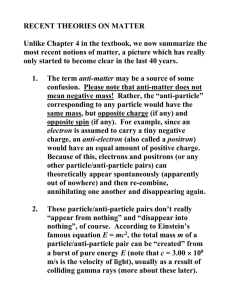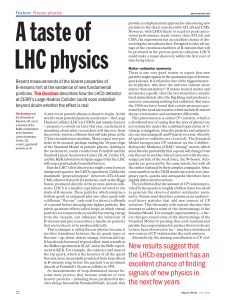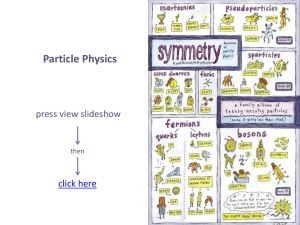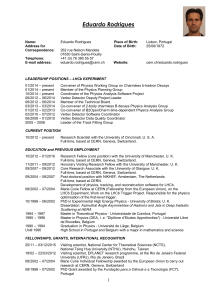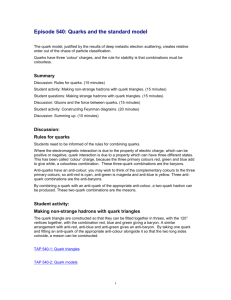Poster - Particle Physics
advertisement
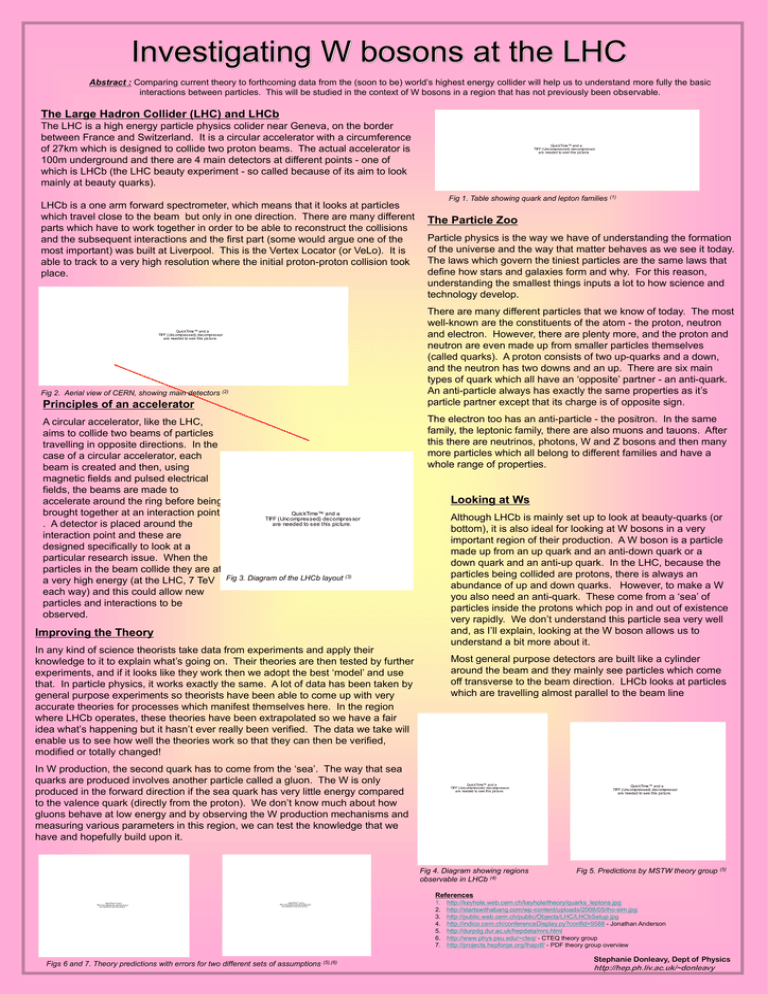
Investigating W bosons at the LHC Abstract : Comparing current theory to forthcoming data from the (soon to be) world’s highest energy collider will help us to understand more fully the basic interactions between particles. This will be studied in the context of W bosons in a region that has not previously been observable. The Large Hadron Collider (LHC) and LHCb The LHC is a high energy particle physics colider near Geneva, on the border between France and Switzerland. It is a circular accelerator with a circumference of 27km which is designed to collide two proton beams. The actual accelerator is 100m underground and there are 4 main detectors at different points - one of which is LHCb (the LHC beauty experiment - so called because of its aim to look mainly at beauty quarks). LHCb is a one arm forward spectrometer, which means that it looks at particles which travel close to the beam but only in one direction. There are many different parts which have to work together in order to be able to reconstruct the collisions and the subsequent interactions and the first part (some would argue one of the most important) was built at Liverpool. This is the Vertex Locator (or VeLo). It is able to track to a very high resolution where the initial proton-proton collision took place. Fig 1. Table showing quark and lepton families (1) The Particle Zoo Particle physics is the way we have of understanding the formation of the universe and the way that matter behaves as we see it today. The laws which govern the tiniest particles are the same laws that define how stars and galaxies form and why. For this reason, understanding the smallest things inputs a lot to how science and technology develop. There are many different particles that we know of today. The most well-known are the constituents of the atom - the proton, neutron and electron. However, there are plenty more, and the proton and neutron are even made up from smaller particles themselves (called quarks). A proton consists of two up-quarks and a down, and the neutron has two downs and an up. There are six main types of quark which all have an ‘opposite’ partner - an anti-quark. An anti-particle always has exactly the same properties as it’s particle partner except that its charge is of opposite sign. QuickTime™ and a TIFF (Uncompressed) decompressor are needed to see this picture. Fig 2. Aerial view of CERN, showing main detectors (2) Principles of an accelerator A circular accelerator, like the LHC, aims to collide two beams of particles travelling in opposite directions. In the case of a circular accelerator, each beam is created and then, using magnetic fields and pulsed electrical fields, the beams are made to accelerate around the ring before being brought together at an interaction point . A detector is placed around the interaction point and these are designed specifically to look at a particular research issue. When the particles in the beam collide they are at a very high energy (at the LHC, 7 TeV each way) and this could allow new particles and interactions to be observed. QuickTime™ and a TIFF (Uncompressed) decompressor are needed to see this picture. The electron too has an anti-particle - the positron. In the same family, the leptonic family, there are also muons and tauons. After this there are neutrinos, photons, W and Z bosons and then many more particles which all belong to different families and have a whole range of properties. Looking at Ws QuickTime™ and a TIFF (Uncompressed) decompressor are needed to see this picture. Although LHCb is mainly set up to look at beauty-quarks (or bottom), it is also ideal for looking at W bosons in a very important region of their production. A W boson is a particle made up from an up quark and an anti-down quark or a down quark and an anti-up quark. In the LHC, because the particles being collided are protons, there is always an abundance of up and down quarks. However, to make a W you also need an anti-quark. These come from a ‘sea’ of particles inside the protons which pop in and out of existence very rapidly. We don’t understand this particle sea very well and, as I’ll explain, looking at the W boson allows us to understand a bit more about it. Fig 3. Diagram of the LHCb layout (3) Improving the Theory In any kind of science theorists take data from experiments and apply their knowledge to it to explain what’s going on. Their theories are then tested by further experiments, and if it looks like they work then we adopt the best ‘model’ and use that. In particle physics, it works exactly the same. A lot of data has been taken by general purpose experiments so theorists have been able to come up with very accurate theories for processes which manifest themselves here. In the region where LHCb operates, these theories have been extrapolated so we have a fair idea what’s happening but it hasn’t ever really been verified. The data we take will enable us to see how well the theories work so that they can then be verified, modified or totally changed! Most general purpose detectors are built like a cylinder around the beam and they mainly see particles which come off transverse to the beam direction. LHCb looks at particles which are travelling almost parallel to the beam line In W production, the second quark has to come from the ‘sea’. The way that sea quarks are produced involves another particle called a gluon. The W is only produced in the forward direction if the sea quark has very little energy compared to the valence quark (directly from the proton). We don’t know much about how gluons behave at low energy and by observing the W production mechanisms and measuring various parameters in this region, we can test the knowledge that we have and hopefully build upon it. QuickTime™ and a TIFF (Uncompressed) decompressor are needed to see this picture. Fig 4. Diagram showing regions observable in LHCb (4) QuickTime™ and a TIFF (Uncompressed) decompressor are needed to see this picture. Fig 5. Predictions by MSTW theory group (5) References QuickTime™ and a TIFF (Uncompressed) decompressor are needed to see this picture. 1. 2. 3. 4. 5. 6. 7. QuickTime™ and a TIFF (Uncompressed) decompressor are needed to see this picture. Figs 6 and 7. Theory predictions with errors for two different sets of assumptions (5),(6) http://keyhole.web.cern.ch/keyhole/theory/quarks_leptons.jpg http://startswithabang.com/wp-content/uploads/2008/05/lhc-sim.jpg http://public.web.cern.ch/public/Objects/LHC/LHCbSetup.jpg http://indico.cern.ch/conferenceDisplay.py?confId=9588 - Jonathan Anderson http://durpdg.dur.ac.uk/hepdata/mrs.html http://www.phys.psu.edu/~cteq/ - CTEQ theory group http://projects.hepforge.org/lhapdf/ - PDF theory group overview Stephanie Donleavy, Dept of Physics http://hep.ph.liv.ac.uk/~donleavy







